
The Alismatales (alismatids) are an order of flowering plants including about 4,500 species. Plants assigned to this order are mostly tropical or aquatic. Some grow in fresh water, some in marine habitats. Perhaps the most important food crop in the order is the corm of the taro plant, Colocasia esculenta.

The Dioscoreales are an order of monocotyledonous flowering plants, organized under modern classification systems, such as the Angiosperm Phylogeny Group or the Angiosperm Phylogeny Web. Among monocot plants, Dioscoreales are grouped with the lilioid monocots, wherein they are a sister group to the Pandanales. In total, the order Dioscoreales comprises three families, 22 genera and about 850 species.

Dioscoreaceae is a family of monocotyledonous flowering plants, with about 715 known species in nine genera. The best-known member of the family is the yam.

Pandanales, the pandans or screw-pines, is an order of flowering plants placed in the monocot clade in the Angiosperm Phylogeny Group and Angiosperm Phylogeny Web systems. Within the monocots Pandanales are grouped in the lilioid monocots where they are in a sister group relationship with the Dioscoreales. Historically the order has consisted of a number of different families in different systems but modern classification of the order is based primarily on molecular phylogenetics despite diverse morphology which previously placed many of the families in other groupings based on apparent similarity. Members of the order have a subtropical distribution and includes trees, shrubs, and vines as well as herbaceous plants. The order consists of 5 families, 36 genera and about 1,610 species.

Nartheciaceae is a family of flowering plants. The APG III system places it in the order Dioscoreales, in the clade monocots. As circumscribed by APG IV (2016) it includes 35 species of herbaceous plants in the following five genera:

The Angiosperm Phylogeny Group (APG) is an informal international group of systematic botanists who collaborate to establish a consensus on the taxonomy of flowering plants (angiosperms) that reflects new knowledge about plant relationships discovered through phylogenetic studies.

Asphodelaceae is a family of flowering plants in the order Asparagales. Such a family has been recognized by most taxonomists, but the circumscription has varied widely. In its current circumscription in the APG IV system, it includes about 40 genera and 900 known species. The type genus is Asphodelus.

The genus Tacca, which includes the batflowers and arrowroot, consists of flowering plants in the order Dioscoreales, native to tropical regions of South America, Africa, Australia, Southeast Asia, and various Oceanic islands. In older texts, the genus was treated in its own family Taccaceae, but the 2003 APG II system incorporates it into the family Dioscoreaceae. The APG III and APG IV systems continue to include Tacca in Dioscoreaceae.

In plant taxonomy, commelinids is a clade of flowering plants within the monocots, distinguished by having cell walls containing ferulic acid.

Triuridaceae are a family of tropical and subtropical flowering plants, including nine genera with a total of approximately 55 known species. All members lack chlorophyll and are mycoheterotrophic. The heterotrophic lifestyle of these plants has resulted in a loss of xylem vessels and stomata, and a reduction of leaves to scales.

Corsiaceae is a family of monocotyledonous flowering plants. The APG II system (2003) treats the family in the order Liliales, in the clade monocots. This is a slight change from the APG system, of 1998, which left the family unplaced as to order, but did assign it also to the monocots.

Thismiaceae is a family of flowering plants whose status is currently uncertain. The Angiosperm Phylogeny Group classifications merge Thismiaceae into Burmanniaceae, noting that some studies have suggested that Thismiaceae, Burmanniaceae and Taccaceae should be separate families, whereas others support their merger.

Boryaceae is a family of highly drought-tolerant flowering plants native to Australia, placed in the order Asparagales of the monocots. The family includes two genera, with twelve species in total in Australia.

Thismia is a genus of myco-heterotrophic plants in family Burmanniaceae, first described as a genus in 1845. It is native to East and Southeast Asia, New Guinea, Australia, New Zealand, and the Americas.

The basal angiosperms are the flowering plants which diverged from the lineage leading to most flowering plants. In particular, the most basal angiosperms were called the ANITA grade, which is made up of Amborella, Nymphaeales and Austrobaileyales.

Lilioid monocots is an informal name used for a grade of five monocot orders in which the majority of species have flowers with relatively large, coloured tepals. This characteristic is similar to that found in lilies ("lily-like"). Petaloid monocots refers to the flowers having tepals which all resemble petals (petaloid). The taxonomic terms Lilianae or Liliiflorae have also been applied to this assemblage at various times. From the early nineteenth century many of the species in this group of plants were put into a very broadly defined family, Liliaceae sensu lato or s.l.. These classification systems are still found in many books and other sources. Within the monocots the Liliaceae s.l. were distinguished from the Glumaceae.

BurmannialesMart. was an order of monocotyledons, subsequently discontinued.


















